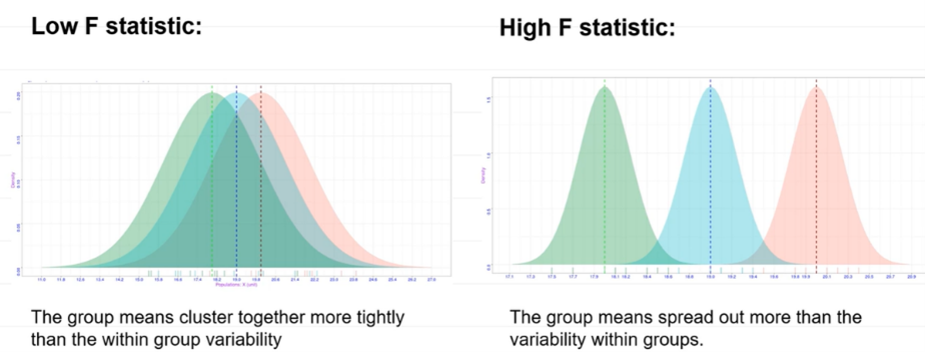Stats 1
1/127
There's no tags or description
Looks like no tags are added yet.
Name | Mastery | Learn | Test | Matching | Spaced |
|---|
No study sessions yet.
128 Terms
categorical data
factor, nominal
no particular relationship between the different possibilities
can’t average them/do maths
eg. job, eye colour, drink preference
continuous data
interval
can do maths
eg. weight, height, reaction time, test score
ordinal data
ordered categorical, factor, likert scale
an order to the sequence
can’t do maths
can talk about frequencies but not averages
eg. grades, how religious someone is
descriptive statistics
central tendency: mean, mode, median
variability: range, variance, standard deviation, interquartile range
they describe what’s going on in the data/sample (not the larger population)
mean
average
for continuous data
sum of all values divided by number of values
outliers are a weakness (anomalies)
can be influenced by very high/low scores
mode
value that happens most often
for continuous/categorical data
one = unimodal
two = bimodal
median
the middle number
for continuous data
sort data in ascending order and find number
can only have one
variability
how spread out the data are
how far away from the mean/median the data points are
only suitable for ordinal/continuous data
range
highest value - lowest value
know the boundaries of our data
useful to detect outliers/data input errors
doesn’t tell how common really high'/low numbers are
variance
how far numbers are spread out from the mean
feeds into other statistics that makes it more useful
= (distance of scores from the mean) / (number of scores - 1)

standard deviation
square root of the variance
describes variability within a single sample - descriptive
measure of average distance of each point from the mean, in the original units
small = data points close to mean
large = data points far away from mean
used to understand the variability in continuous/ordinal data

interquartile range
split our data into quarters (each contains 25% of the data points)
put data into ascending order
find the median (Q2)
find the median of the first half (Q1)
find the median of the last half (Q3)
Q3 - Q1
the range (max-min) is the middle 50% of data
useful as it isn’t affected by outliers
when an odd number of data, find median, then in first half find the median while ignoring the Q2
histograms
use these to graphically visualise the frequency distribution of continuous data (eg. heights, weights, depression, reaction time)
make bin categories and then a frequency table, with frequencies of values in each bin
frequency on Y axis
the mode is the bin with the tallest bar
useful to see the shape/distribution of the data
tukey boxplot/box and whiskers
used to visualise continuous data and provide statistical summaries of data
shows 5 descriptive statistics in one plot
minimum bound
quartile 1
median (Q2)
quartile 3
maximum bound
plus outliers (statistically different to rest of data)
elements:
interquartile range = Q3-Q1
min and max bounds (not the true minimum and maximum, but the largest data points above and below the thresholds
thresholds in a boxplot
Q1 – (1.5xIQR)
Q3 + (1.5xIQR)
interpreting a boxplot
each section contains 25% of the data
shorter whisker = data will be quite similar (less variability)
longer whisker = data will have more variability
skewness
asymmetry is caused by the presence of extreme values that distort the shape of the data, which is why symmetrical distributions are quite rare
characterised by a long gentle tail on one side of the distribution and a shorter steeper tail on the other
about horizontal shape of distribution
negative skew - less than -2
normal skew - 0 (between -2 and +2)
positive skew - more than 2
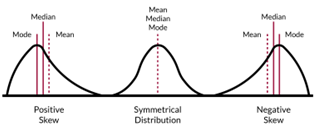
symmetrical distribution
same shape on both sides (bell curve)
mean, mode and median very similar
in a box plot, the median line is central with equal proportions throughout
negative skew
longer tail slopes to the left
mean is lower than the median, which is lower than the mode
in a box plot, median and upper whisker are closer to the right/top
less than -2
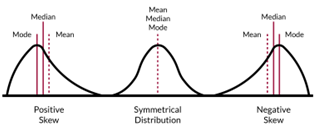
positive skew
longer tail slopes to the right
mode is lower than the median, which is lower than the mean
in a box plot, median and lower whisker are closer to the left/bottom
more than 2
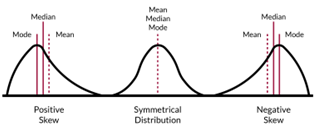
kurtosis
used to describe the shape of a distribution
an indicator of the number of extreme values in data
3 categories:
mesokurtic - 3, conforms to classic bell curve shape
platykurtic - less than 3, flatter profile with shorter tails indicating fewer outliers
leptokurtic - more than 3, narrower center and longer tails indicating more outliers
kurtosis between 1 and 5 is within acceptable limits of normality for a given distribution (-2 and +2)
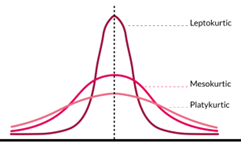
calculating skew by hand
Pearson’s coefficient of skewness
negative number = negatively skewed
positive number = positively skewed
skew of 0 = symmetrical data
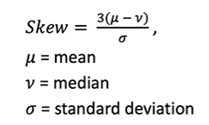
bimodality
2 modes
not shown well in a box plot, so making a histogram is useful to show the distribution of the data properly
plotting extreme values
general weirdness
need to consider context of extreme values
robust statistics
the median
less vulnerable to distortion by extreme values
for some data, the median will provide a better estimate of central tendency than the mean
interquartile range less vulnerable too
non-robust statistics
the mean
extreme values can have a noticeable effect on it
SD also vulnerable to distortion by outliers, as it’s calculated using the mean
population
the entire group of individuals or items that a statistical analysis aims to describe or draw conclusions about
all the hypothetical individuals we want to understand something about
isn’t just all physical people currently existing, but a more abstract concept of all infinite individual that have/could exist
sample
randomly chosen individuals from the population who we test/study, which we assume represent the whole population
in reality, many samples are not random when studies are volunteer = bias (random is ideal though)
can calculate descriptive statistics to understand the sample, but these only describe the sample not the wider population
larger the sample size, the more precise the estimates about the population will be
statistical model
a mathematical and simplified representation of observed data/behaviour/reality, used to make predictions or draw inferences about the sample and generalise to the whole population
simplifies reality/complex matters to understand relationships between variables
all models are wrong - they are representations of a thing that doesn’t necessarily capture all the complexity of reality but are still useful to use eg. London underground map
perfect correlation model:
data perfectly linear
data would all lie on line of best fit
can work out one variable if we know the other
can be relatively confident our model is reliable and appropriate for our data by understanding the assumptions it makes
if we reduce the discrepancy between the assumptions and our data, our model allows us to draw useful conclusions about the process that generates our data
they are also machines eg. the Rube-Goldberg machine (intentionally designed to perform a simple task in an overly complicated way
simple model
describing central tendency and variability in a measure
complex model
big network of how different variables connect to each other
normal distribution
a probability distribution as a bell shaped curve
1 peak (mean, median, mode are equal)
can use SD as a unit of measurement (a data points distance from the mean can be measured using a number of SDs)
eg. histograms
defined by its density function (density plots)
follows the 68-95-99.7 rule
properties:
symmetric about the mean/centre
tail never hits 0
characterised by mean and SD
X in continuous
Y is defined for every value of X
what gives the curve its’ smoothness
ranges from minus and plus infinity
non-continuous/discrete data = binary outcomes, count data, ordinal, psychometric scales
eg. IQ - total score of standardised tests to assess human intelligence (mean = 100, SD = 15)
density plots
shows relative likelihood of x taking on a certain value
normal distributions are defined by its density function
low standard deviation on a normal distribution
tall skinny curve
high standard deviation on a normal distribution (dispersed data)
flat wide curve
proportions under the normal distribution curve
68-95-99.7 rule
68% of data falls within 1 SD of the mean (34% above and 34 below)
95% of data falls within 2 SDs of the mean (47.5% above, 47.5 below)
99.7% of data falls within 3 SDs of the mean (49.85% above, 49.85 below)
the last 0.3% is above/below 3 SDs away from the mean
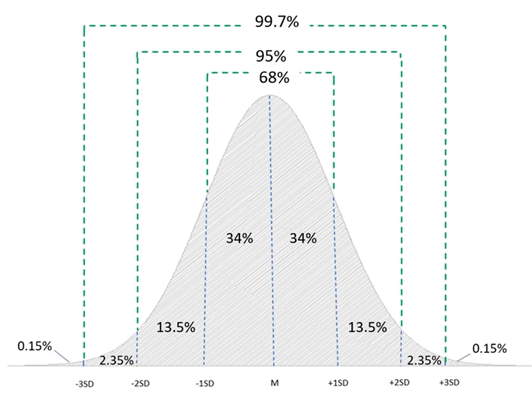
inferential statistics
these make predictions, inferences and conclusions about the wider population based on samples of data
help assess the probability that a certain hypothesis is true
involves estimation of parameters and testing of statistical hypotheses
sample statistics
mean/median/mode
estimates the population mean
can be used to estimate parameters
population parameters
true mean/median/mode
likely the sample mean will be different to the population mean, so the inferences made will always be vulnerable to error
can use sampling distribution to estimate this error
sampling distribution
the SD of the distribution of sample means will be smaller than the SD within the population
means of samples will be less dispersed than they are in the population (same mean but smaller dispersion)
sampling distribution of a statistic
a probability distribution based on a large number of samples from a given population
sample mean = population mean
SD of sample < SD of population
SD here is called standard error (to distinguish it from the SD of one sample population)
standard error (SE)
estimates variability across samples - inferential
the more samples used, the less variable the means will be so SE
estimates whether a sample mean will be bigger/smaller than the population mean
shows how accurately the mean of a sample represents the true mean of the population
the smaller the SE, the more accurate the sample mean is close to the population mean
use it to calculate the confidence interval
difference between SD and SE
SD describes variability within a single sample - descriptive
SE estimates variability across multiple samples - inferential
calculating standard error
divide sample SD by square root of observations/number of samples

size of SE influenced by 3 factors
SD within the sample (larger SD = larger SE)
size of the sample (larger sample = sample mean closer to population mean)
proportion of the population covered by the sample (larger proportion covered in samples = lower variability of the means) - this has less influence on SE
confidence interval (CI)
how accurate an estimation of a population parameter will be
normally indicated as a % where the population mean lies within an upper and lower interval
use this to indicate the range we are pretty sure the population mean lies between 90, 95, 99% CIs
the larger the CI, the less precise the estimation of the population parameter
what would a 95% CI mean
a range of values that you can be 95% confident will contain the true mean of the population
what influences the size of CIs
variation
low variation = smaller CI
high variation = larger CI
sample size
smaller sample = more variation = larger CI
larger sample = less variation = smaller CI
calculating confidence intervals
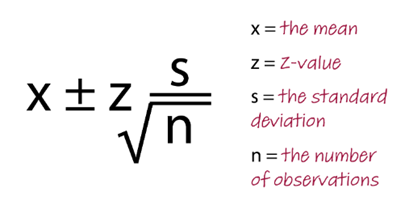
Z value
how many standard deviations a value is from the mean of a distribution
a measure of how many SDs the raw score is above/below the population mean (data that is recorded before going through statistical analysis)
based on a normal distribution
ranges 3 SDs above and below the mean
hypothesis testing steps
process of making inferences based on data from samples in a systematic way, to test ideas about the population
1) defining the null hypothesis
2) defining the alternative hypothesis
3) determining the significance level
4) calculating the p-value
5) reaching a conclusion
hypothesis testing 1) defining the null hypothesis
this assumes there is no difference between groups
nullifies the difference between sample means, by suggesting it is of no statistical significance
tests the possibility that any difference is just the result of sampling variation
hypothesis testing 2) defining the alternative hypothesis
predicts/states there is a relationship between the 2 variables studied
null hypothesis is assumed unless the difference between sample means is too big to believe the samples are the same (reject null hypothesis if differences become too big)
hypothesis testing 3) determining the significance level
typical level = 0.05 / 5%
known as the alpha
defines the probability that the null hypothesis will be rejected
similar outcomes reproduce 95% of potential replications
implies that in 5% of replications we will:
observe an effect that isn’t real (type 1 error)
fail to find an effect that does exist (type 2 error)
hypothesis testing 4) calculating the p-value
the probability value
how plausible is our data if there was actually no effect (null hypothesis true)
shows probability of an observed effect if the true (unknown) effect is null
between 0 (never) and 1 (always) probability
compare this against the significance level (alpha value)
p<alpha = significant
p>alpha = not significant
a p-value of 0.0125 means if the null hypothesis is true, the probability of obtaining results as/more extreme than those obtained is equal to 0.0125
if the p value is LESS THAN (<) alpha/significance level
reject null hypothesis
in favour of alternate hypothesis
results are statistically significant
we always say ‘reject (or fail to reject) null hypothesis’ when talking about significance, not ‘accept alternative hypothesis’
if the p value is GREATER THAN (>) alpha/significance level
fail to reject the null hypothesis - as this is evidence for the alternate hypothesis
results are NOT statistically significant
data is not inconsistent with null hypothesis
we don’t learn anything as evidence is inconclusive
if p-value is exactly 0.05, we still fail to reject null hypothesis
type 1 error
reject a true null hypothesis
rejecting it when should be accepting it
false positive
probability of making this error is represented by the significance level
can reduce risk by using a lower p-value (0.01 instead of 0.05)
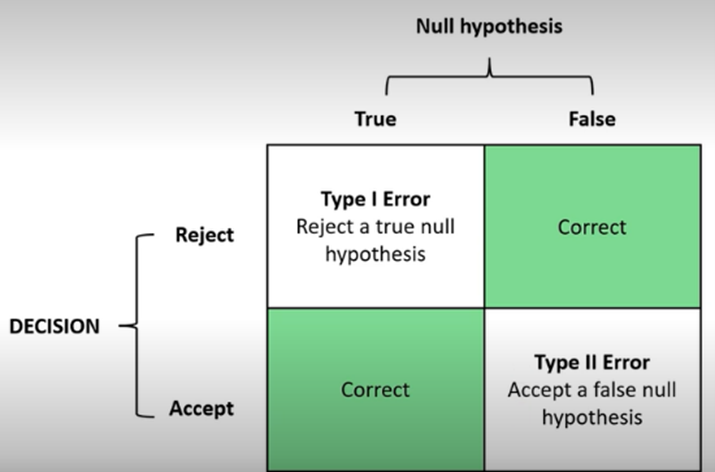
type 2 error
accept a false null hypothesis
accepting it when should be rejecting it
false negative
probability of making this error is know as beta
can reduce risk by making sure the sample size is large enough to detect a difference when one exists
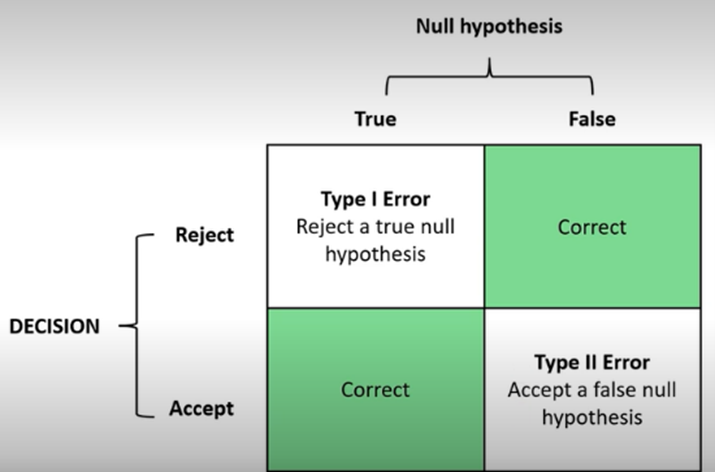
regions of rejection
determined by the alpha level
known as critical region too
set of values for a test statistic that lead to the rejection of a null hypothesis
the term 1/2 tailed test refers to where these regions are
two-tailed test
non-directional
region where you reject the null hypothesis is on both tails of the curve
eg. alpha level of 0.05 - split between the 2 tails evenly, giving 2.5% to each tail (these are regions you reject null hypothesis)
research question would not specify the direct of effect (eg. difference, impact, affect)
one-tailed upper test
region where you reject the null hypothesis is on the right side/upper end of the curve
eg. alpha level of 0.05 - alpha is all at one end (not split evenly), giving 5% to the upper tail only (region to reject null hypothesis)
upper tail contains upper values in a distribution = higher numbers will appear here so research questions specify the direction of effect (eg. greater/more than, higher)
one-tailed lower test
region where you reject the null hypothesis is on the left side/lower end of the curve
eg. alpha level of 0.05 - alpha is all at one end (not split evenly), giving 5% to the lower tail only (region to reject null hypothesis)
lower tail contains lower values in a distribution = smaller numbers will appear here so research questions specify the direction of effect (eg. lower/less than, decrease)
quantitative research
develop research question and hypotheses using literature review
design study
determine analyses (need to know method, analysis depends on study design)
collect data
analyse data
interpret data
disseminate results
choosing an inferential test
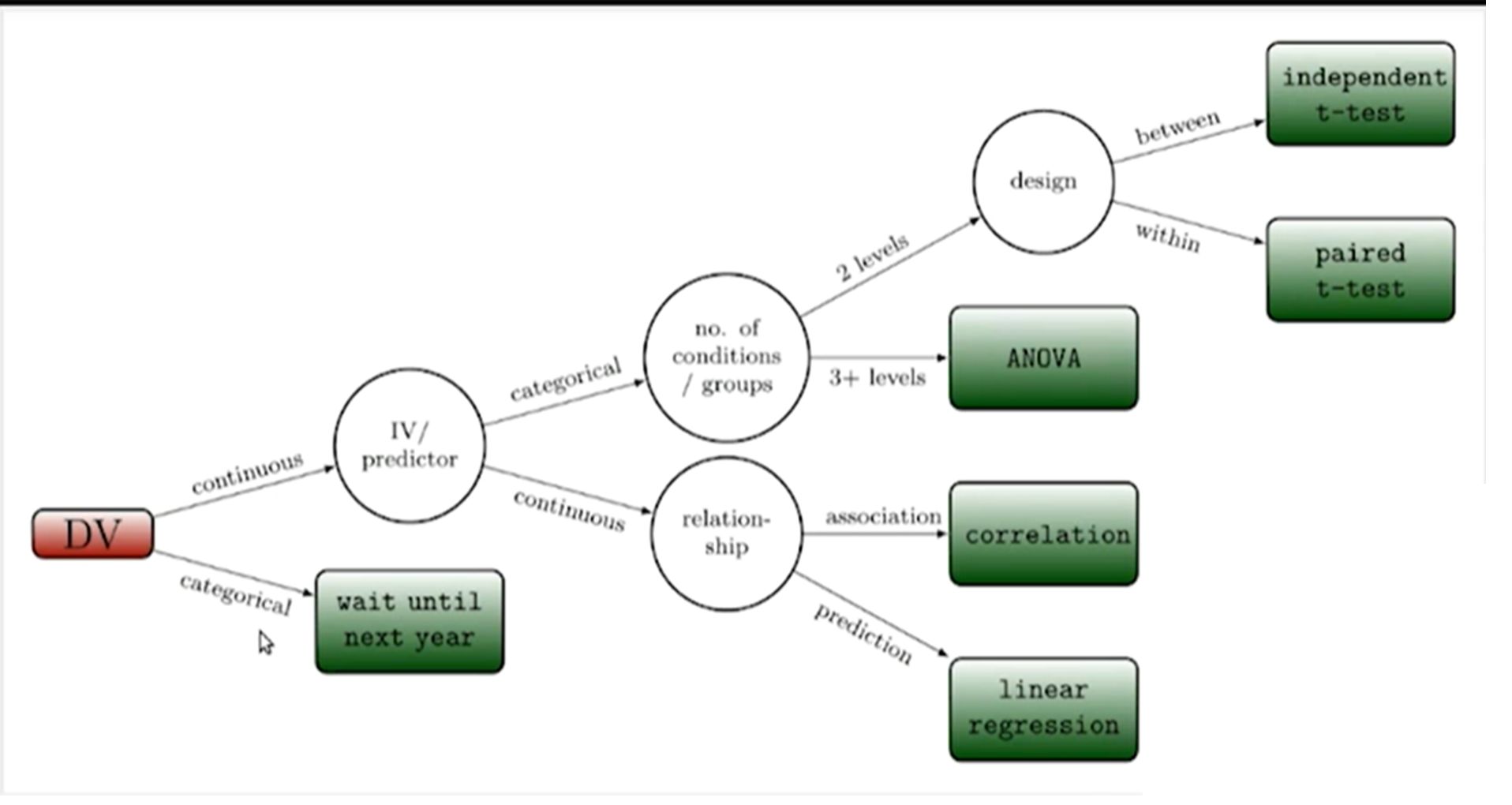
uni-variate data
1 variable
eg. asking 100 people their height and nothing else
summarising - mean and SD
visualising - histograms, box plots
understanding - results, normal distribution/skewness
can only answer simple questions
doesn’t help us understand why people act/think the way they do
bi-variate data
2 variables
eg. asking 100 people their height and weight
can be 2 continuous, 2 categorical or 1 of each
scatterplots
used with 2 continuous variables
a correlation used to measure strength of relationship between 2 variables
shows how much of the variance in 1 is explained by another
each point represents an observation
can see pattern, spread and orientation of the data
bigger sample size is better to reveal if relationship is real, but significant relationships aren’t the same as strong ones
interpreting scatterplots
shows how much of a relationship there is and the type
look at line of best fit, see how far spread out data points are from line, if there’s any anomalies
types of relationships:
linear
curvilinear
exponential
linear relationships
straight line
as one variable changes, the other changes
rate of change remains constant
curvilinear relationships
as one variable changes, the other changes but only up to a certain point
after this point, there’s no relationship or direction of it changes
eg. Yerkes-Dodson
exponential relationships
as one variable changes, another changes exponentially
eg. world population
positive relationship
one variable increases, the other increases
negative relationship
one variable increases, other decreases
no relationship
scatterplot points don’t form a pattern
correlations quantify relationships
strength - how much of a relationship
significance - likelihood of finding the observed relationship in the sample, if there was no relationship in the population
variance explained by our model
line through all data points
line of best fit - smallest distance = bigger effect
models the correlation and relationship between variables
correlation
association between 2 continuous variables
Pearson’s estimates how much of the variance in one variable can be explained by another variable
Pearson’s correlation coefficient (r)
size of the effect = correlation coefficient (r) - between -1 and +1
squaring the correlation coefficient tells how much variance in the data is explained by the model - can convert to %
no relationship - r=0
moderate - r=0.5
perfect relationship - r=+1 or r=-1
linear regression
a modelling technique used to make predictions about an outcome variable, based on 1+ predictor variables (1 = simple linear regression)
establishes link/relationship between outcome and predictor variables
regression is the foundation to other types of regression analysis
tells us:
strength of relationship between 2 continuous variables (so does correlations)
statistical significance (so does correlations)
how much one variable changes as another variable changes
the value of one variable if the other variable was 0
can predict a person’s score on a variable
includes effect size, slope and intercept
change in outcome variable (DV) for every unit increase in the predictor variable (IV)
outcome y can be predicted as linear function of x
regression as a model
predictor variable (x) → outcome variable (y)
arrow points towards variable trying to be predicted
both continuous
still cannot infer causality
effect size - linear regression
shows the strength of relationship between 2 continuous variables
R2 is a proportion of the variance explained by model (x100 to get %)
how well does the model (regression line) represent the data
strength of relationship (0-1)
modeled by how close our data points are to line of best fit
better the model, closer the points are to line of best fit
slope
beta (β)
shows how much one variable changes as another variable changes
essentially the line of best fit
intercept
a / constant (β0)
where the line of best fit intersects the y-axis
the value of one variable (outcome) if the other variable (predictor) was 0
using regression for predictions
if value of x is known for a given participant, we can predict y
y = bx + a + error
y = (slope x x) + intercept + variance explained by other stuff
the error is taken off for predictions
independent t-test
used to establish whether 2 means collected from independent samples differ significantly (difference between groups)
the null hypothesis is that the population means from the 2 unrelated groups are equal (most the time we reject the null and accept alternative - means are NOT equal)
the difference between the means of 2 independent groups
t = difference between groups / variance within groups
more extreme t value (>2) indicates less overlap between groups
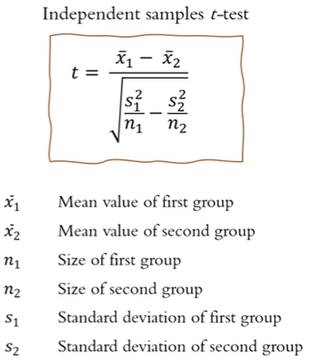
features of independent t-test datasets
1 independent variable with 2 independent groups (between groups design)
1 dependent variable measured using continuous and normally distributed data
what do independent t-tests take into account
the mean difference between samples
variance of scores
sample size
t-statistic
produced from a t-test
the ratio of the mean difference between the 2 groups and the variation in the sampled data
uses the mean difference between samples, sample size and variance of scores
paired samples t-test
repeated measures - compare samples where each group participated in both conditions
data is collected from the same participant for both sets of observations (paired observations)
used to establish whether the mean difference between 2 sets of observations is 0
average size of change for each participant
t = score change / variance of that change
degrees of freedom = number of pairs - 1
features of paired samples t-test datasets
1 independent variable with 2 dependent groups (within groups design)
1 dependent variable measured using continuous and normally distributed data
one-way ANOVA
analysis of variance
tests whether there are statistically significant differences between 3+ samples (between-groups design)
one-way is specifically for samples that are independent groups
tests the null hypothesis that the samples in all groups are drawn from populations with the same mean values (and there is no significant difference between them)
accounts for both the variance between groups and within groups
features of a one-way ANOVA
1 independent variable with 3+ conditions/levels/groups
1 dependent variable measured using continuous and normally distributed data
ANOVA terms
one-way = 1 independent variable
factorial = multiple independent variables
ANCOVA = covariate (control variable)
MANOVA = multiple dependent variables
factors = independent variables
effects = quantitative measure indicating the difference between levels
why is multiple testing/comparisons a problem
if we adopt alpha level of 0.05 and assume the null hypothesis is true, then 5% of the statistical tests would show a significant difference
the more tests we run, the greater likelihood that at least 1 of those tests will be significant by chance (type 1 error - false positive)
when multiple testing issues arise
looking for differences amongst groups on a number of outcome measures
analysing data before data collection has finished, then re-analysing it at end of collection (this violation often used to see whether more data needs to be collected to reach significance)
unplanned analyses (conducting additional ones to try to find something of interest)
how to solve multiple testing issues
avoid over-testing (plan analyses in advance)
use appropriate tests
when multiple tests are run, adjust the alpha threshold
test statistic
a value that is calculated when conducting a statistical test of a hypothesis
shows how closely observed sample data matches the distribution expected under the null hypothesis of that statistical test
used to calculate the p-value of results
eg. t-test produces t statistic, ANOVA produces f statistic
the F statistic
an ANOVA produces this test statistic
a ratio of 2 variances (mean squares)
how much more variability in the data is due to differences between conditions/groups, as opposed to the normal variability
this along with degrees of freedom are used to calculate the p-value
if variants of the between groups is similar to the variants of the within groups, F statistic will be near 1
calculation: variance between groups/variance within groups
